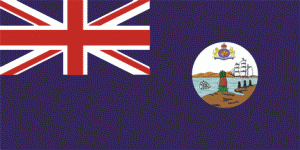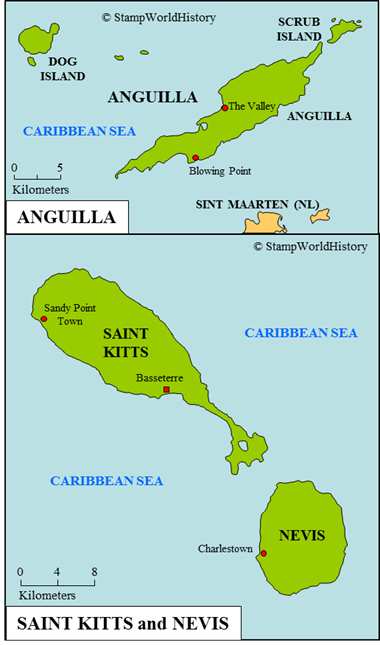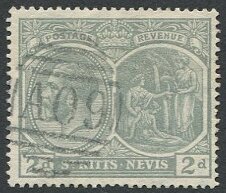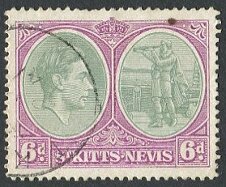
Saint Kitts, Nevis & Anguilla
Quick reference
General issues: Saint Kitts & Nevis/Presidency Leeward Islands 1903-1952, Saint Kitts, Nevis & Anguilla/Presidency Leeward Islands 1952-1956, British colony 1956-1958, Province West Indies Federation 1958-1960, British colony 1962-1967, Associated state 1967-1980
Country name on general issues: St. Kitts & Nevis, St. Christopher & Nevis, St. Christopher, Nevis & Anguilla
Currency: 1 Pound = 20 Shilling, 1 Shilling = 12 Pence 1903-1949, 1 Dollar = 100 Cent 1949-1980
Population: 46 500 in 1901, 51 300 in 1980
Political history Saint Kitts, Nevis & Anguilla
Saint Kitts & Nevis consists of Saint Kitts, Nevis and Anguilla and is located in the Caribbean, the islands being part of the Lesser Antilles. For the exact location, please refer to the map of the Caribbean. Prior to colonization, the islands were inhabited by the Amerindian Carib people – a people found on many of the Lesser Antilles. At the time of colonization, Anguilla was uninhabited. The first European to sight the islands was Christopher Columbus in 1493 – although this is disputed for Anguilla. The British were the first to establish permanent settlements on the islands. Saint Kitts was settled in 1625, Nevis in 1628 and Anguilla in 1650. Throughout the 17 and 18th centuries, the islands were disputed between France and Great Britain, until France recognized British sovereignty in 1783.
From the 17th until the 20th century, the islands were administered as part of the Leeward Islands colony – the federal colony that grouped together British possessions in the Leeward Islands. Anguilla was made a dependency of Saint Kitts in 1825 – a decision that was resented by the Anguillians, who, throughout the 19th and 20th centuries, would petition several times to be administered as a separate colony. In 1871, Saint Kitts and Nevis were formally designated as presidencies of the Leeward Islands colony. Shortly after, in 1883, Saint Kitts and Nevis were grouped together as the presidency of Saint Kitts & Nevis. As did Anguilla, Nevis opposed being joined to Saint Kitts. The presidency of Saint Kitts & Nevis was renamed Saint Kitts, Nevis & Anguilla in 1952.
When the Leeward Islands colony was dissolved in 1956, the presidency became the colony of Saint Kitts, Nevis & Anguilla. As such, between 1958 and 1962, it joined the West Indies Federation – the short lived federation of most of the British possessions in the Caribbean. In 1967, Saint Kitts, Nevis & Anguilla became an associated state. Anguilla revolted, demanding to be separated from Saint Kitts and Nevis. Anguilla would, subsequently, be administered as a de facto separate colony until granted the de jure status of a separate British dependency in 1980. Consequently, Saint Kitts, Nevis & Anguilla was, in 1980, renamed Saint Kitts & Nevis and would gain independence within the British Commonwealth in 1983. Saint Kitts & Nevis is currently a federation with a large degree of self government for Nevis.
Economically, the British, in the 17th and 18th centuries, developed sugar cane plantations on the islands. To man the plantations, slaves were brought from Africa. In particular, Saint Kitts and Nevis developed to rank among the wealthiest British colonies, until the sugar cane trade went into decline in the 19th century. Yet, sugar cane would remain the main economic activity until the late 20th century, when the focus was shifted to tourism. The population of the islands is predominantly black.
Postal history Saint Kitts, Nevis & Anguilla
The first stamps used were the general issues of Great Britain. These were used on Saint Kitts and Nevis between 1858 and 1860. The first post office on Anguilla was not opened until 1904. Saint Kitts and Nevis issued stamps from 1870 and 1861 respectively and continued to do so when grouped together as Saint Kitts & Nevis. In 1890, the stamps of the individual islands were superseded by the issues of the Leeward Islands. The issues of the Leeward Islands were used exclusively until 1903, when Saint Kitts & Nevis issued is first stamps – stamps that would be used concurrent with the issues of the Leeward Islands until 1956.
The stamps issued for Saint Kitts & Nevis, in the classical period, are of designs specific for the presidency and reflect the identity of its constituent parts – the seals of Saint Kitts and of Nevis are the recurrent theme in the designs. Aside from the country specific issues, Saint Kitts & Nevis joined in a number of omnibus issues for the British colonies. In the modern era the name was changed to Saint Kitts, Nevis & Anguilla. The stamps issued in the modern era use mainly themes of national interest. The stamps of Saint Kitts, Nevis & Anguilla were used on Anguilla until 1967, when Anguilla de facto seceded. Saint Kitts, Nevis & Anguilla issued stamps until 1980 when Anguilla de jure seceded and the new associated state of Saint Kitts & Nevis was formed. Modern day Saint Kitts & Nevis never issued stamps: since 1980 Saint Kitts and Nevis have each issued their own stamps.
The alternate name for Saint Kitts is Saint Christopher. Saint Christopher would seem to be the official name, however, Saint Kitts is, the most commonly used name. A Saint Kitts & Nevis passport is inscribed ‘St. Christopher (St. Kitts) and Nevis’. On the stamps issued, both names were used as follows:
- Between 1870 and 1890 the stamps issued by Saint Kitts as a separate presidency were inscribed ‘Saint Christopher’.
- Between 1903 and 1951 the stamps issued by Saint Kitts & Nevis were inscribed ‘St. Kitts & Nevis’ with the exception of two omnibus sets issued in 1935 and 1938 that are inscribed ‘St. Christopher & Nevis’.
- Between 1952 and 1980 the stamps issued by Saint Kitts, Nevis & Anguilla are inscribed either ‘St. Kitts, Nevis & Anguilla’ or ‘St. Christopher, Nevis & Anguilla’.
- Since 1980, the stamps issued by Saint Kitts are inscribed ‘St. Kitts’.
For an overview of the political and postal developments in the form of a diagram, please refer to the country diagram of the British Leeward Islands.
Album pages
← Previous page: Saint KittsNext page: Saint Lucia →





